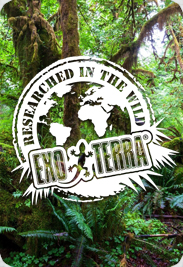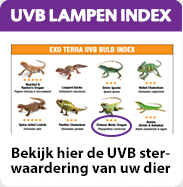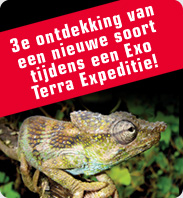Expeditie 2004 - Madagaskar / Het logboek
Destination: Ampasindava peninsula, North-western Madagascar
Season: Dry season
Date: June-July 2004
Objective: Explore the herpetological biodiversity and ecology

Up the Kongony river in a pirogue that barely holds two people. These pirogues are made out a single tree trunk
In June 2004, the Exo Terra expedition left Paris for one of the remotest and inhospitable parts of the 'Red Island': Madagascar. It took the expedition team four flights, a 10 hour ocean trip and several hours by pirogue through the natural canals of the dense mangrove forests, to finally be able to install the first campsite. Although it was supposed to be the dry season, it wasn't. Tents had to be erected in pouring rain, and the team's equipment was drenched. With everything soaked, the only remaining purpose of the inside-out tent was for protection against the millions of biting mosquitoes. Madagascar is one of the world's high-risk areas for Malaria, a mosquito-transmitted and often fatal disease.
The next morning looked more promising, as the sun's strong rays woke the team members up early. This early start made it possible to reach our final destination, a mountain ridge covered with pristine rainforests, the same day. The first part of this journey was easy, or at least not tiring, since it was done by pirogue up the Kongony River. This river is one of the only places in Madagascar where the Nile crocodile is still found in large numbers. Considering the size of the pirogues (smaller than the largest crocs), a scary thought! The second part of the journey was a combined crawl and climb of 10 km up to the mountain ridge, located at an altitude of 500 meters. A small area in the dense primary forest was cleared of twigs, branches and lianas to build the second campsite. The clear skies this time made it possible to light a campfire and prepare one of the freeze-dried meals, a Spaghetti Bolognese.

Bemanevika Village, one of the only villages along the river
The meal gave the team the strength for the first nightly survey around the camp site. Since this area remained unexplored by herpetologists and biologists we did not know exactly what species to expect, but we suspected the occurrence of Uroplates or Malagasy leaf-tailed geckos. The problem in finding these geckos is their incredible camouflage capability. When resting on a tree trunk, they blend in perfectly with the bark of the tree and its lichens and mosses. During their night time activity hours they are much easier to spot, thanks to their specific shape and white bellies. Several of the giant leaf-tailed geckos, Uroplates henkeli, were found hunting for insects. The search for the small leaf-tailed, Uroplates ebenaui, was unsuccessful, but other gecko family members like Paradoera oviceps and Geckolopis maculata were located.

A well camouflaged leaf-tailed gecko, Uroplates henkeli

A leaf-tailed gecko contrasting on a green bamboo pole

The giant Furcifer oustaleti was sighted several times during the expedition

The conspicious Phelsuma klemmeri
The next morning everyone was anxious to explore the area by daylight and the blue sky looked very promising. At breakfast, crackers with honey, the survey areas were determined and the planning for the next few days was set out. The first micro-habitat to research was a huge bamboo patch within the pristine forest. It was medium sized bamboo, about 5 cm (2") thick and 6-7 meters high, that grew tightly together. The dead bamboo poles lay crisscrossed, intertwined like a giant game of Mikado. The first reptile to be sighted was again the Uroplates henkeli, sleeping on a green bamboo. The reptile was easily spotted as its brown camouflage colours and pattern contrasted with the leafy green bamboo. Around the same time the first rainforest species of day gecko was found, a Phelsuma seippi that also seemed to prefer the medium sized bamboo. A heavy rain shower made an early end to this interesting survey.

Some of the team members at the second campsite in the primary rainforest
The afternoon showers created the perfect conditions to spot amphibians at night. On that specific night, the humidity rose around a 100% and throughout the forest a chorus of hundreds of frogs created a very pleasant atmosphere. We heard many more frogs than we actually saw. No wonder when you know that many of these frogs belong to the world's smallest species and live in between the leaf litter on the forest floor.
We were very lucky to spot the tiny Stumpffia pygmaea (1 cm or 1/2"), Madagascar's smallest frog. Also various tree frogs like Boophis tephraeomystax and Mantidactylus sp. were recorded for the first time in this part of Madagascar.
The sun was already present when the team opened their tents the next morning. After freshening up in the mountain stream, the team headed again for the bamboo patch that was partly surveyed the day before. Upon arriving at the site, one of the team members noticed a leech stuck to his foot. This parasite was probably waiting for a victim in the mountain stream where we had bathed earlier. The leech was removed with a hot knife, and the team could start the survey. Emmanuel, the Exo Terra manager and team leader, spotted a very small green gecko, but before we could take a closer look the animal vanished in the tiny leaves of the bamboo. An extended search for the animal or similar ones was unsuccessful but everyone was determined to find one of these tiny green geckos. It certainly looked like an undiscovered species. During the search however, the most conspicuous of all day geckos was found, Phelsuma klemmeri. This was certainly the first observation of this species in its natural habitat since it was first discovered in 1991. Seeing these metallic blue geckos with their yellow heads was very exciting for all the team members and was one of the highlights of the expedition. Other members of the gecko family found on this day were the giant day gecko, Phelsuma madagascariensis grandis and Phelsuma laticauda laticauda. Unfortunately the little green gecko that we first observed was never found again.
A few days later during one more attempt to find the 'tiny green one' (as the team members named the elusive gecko), the team left the base camp very early in order to be at the site by sunrise. Every team member took up position under a specific bamboo patch. Emmanuel observed the patch where the 'tiny green one' had first been sighted.
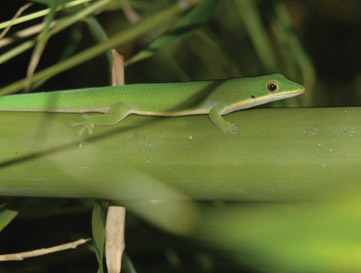
The recently discribed Phelsuma vanheygeni, discovered during the expedition and named after Exo Terra manager Emmanuel Van Heygen
He had to wait until 10 o'clock before the little creature finally showed itself again! But this time it was certain, a new species of day gecko was discovered! It took the team another 2 hours to capture it for further investigation and photography. The joy amongst the expedition members was great and one of our Malagasy friends ran back to the base camp to get some warm beers, semi-fresh vegetables, and two cans of sardines while others built a table, chairs and even cutlery out of bamboo. The table was covered with a giant leaf of the traveller's palm and suddenly this damp forest area looked like a ballroom. This had to be celebrated! As desert, a fresh honeycomb with delicious sweet honey was served.
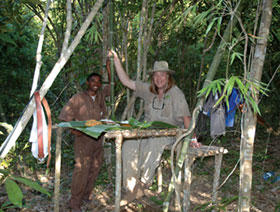
Celebrating the new species’ discovery on an improvised 'jungle' dining table

After this successful day, the Exo Terra expedition broke down the camp site and moved southwards to the village of Bemanivika where we hoped to get some fresh supplies like bottled water and vegetables. We knew not to expect cold beverages since there is no electricity on the peninsula. After we found what we were looking for, the expedition headed back into the forest to find a spot to build a new campsite. That evening, the previous day's discovery was much talked about around the fire as it was certainly the highlight of the Exo Terra expedition.
In the morning the pristine rainforest was beautifully lit up by the first sun-rays that played through the lianas and leaves of the forest's giant trees. Close to the camp, again a bamboo patch was located and many of us were anxious to take a closer look.
What took us days before, all the species we observed over the past week, were found here again in great numbers, including the 'tiny green one' and the conspicuous Phelsuma klemmeri.
Suddenly, away from the bamboo in a tall palm tree, another tiny green gecko was sighted! It was basking very high up, on one of the top-most giant leaves. No chance to get there we thought. But one of the Malagasy swiftly turned into a lemur and climbed to the crown of the tree in no time; cut off the leaf; and threw it, along with the gecko still attached, down to the ground. To our surprise, it contained another tiny day gecko species, Phelsuma quadriocellata parva, which had thus far only been found on Madagascar's eastern coast. No record of it having been spotted on the north western coast existed.
Over the next few days and nights many other micro-habitats were researched and many reptiles and amphibians were found. Because it was within the dry season only a few chameleons were sighted like Furcifer oustaleti, Furcifer pardalis or panther chameleon, and the tiny and rare Calumma boettgeri. We had to wait for another major discovery, which happened on the last day in the forest. Hidden between the leaf litter we found a more than 2 meter (7 feet) long Madagascar ground boa, Acrantophis madagascariensis waiting for prey to pass. Tired, everyone went to sleep early, since the next day we had to walk for several hours back to the pirogues waiting for us on the Kongony River.

Breaking down the campsite
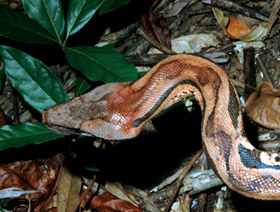
Acrantophis madagascariensis
Before sunrise the expedition left the pristine forest areas, longing for a dive in the ocean, but first having to muddle through the mangroves again. With heartache we left the dense forest and its animals behind us. The team was quiet as we drifted slowly along the dense walls of mangrove trees in our pirogues. This silence was broken abruptly as soon as we reached the beach and the open sea again. It was the first time that we all could safely dive into the water without the fear of leeches and crocodiles. We all enjoyed two more days on this remote and beautiful tropical beach, still some of us could not resist investigating the bushes and trees behind the beach, while others enjoyed the turquoise blue ocean.
A boat appeared on the horizon, one that was certainly travelling faster than the tiny local pirogues with their square sails. Everyone realized that this was the end of an extraordinary journey into one of Madagascar's remotest corners. The boat brought us back to civilization where a hot shower and a cold beer awaited.

One of the many crocodiles in the Kongony river, bigger then our tiny pirogues
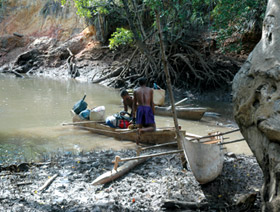
Packing the first pirogues with the equipment to head back for the coast through the mangroves


